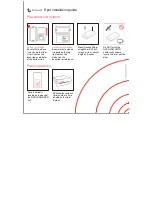
10. Circuit explanation
The U4B tracker has a rather simple design and does not require highly detailed explanation.
The brains of the device is an STM32F103CBT6 microcontroller. A 32-bit ARM Cortex M3
processor having 128K of program memory. In the U4B, 12K is used for the bootloader and 116K
for the application firmware. Although the maximum speed of the microcontroller is 72MHz, it is
run at a much lower speed in this leisurely application, to reduce current consumption. There is an
8MHz crystal as the system oscillator; internally this is used to generate a 4MHz CPU clock during
flight, or 18MHz when a USB connection to a host PC is present.
The USB connector is a micro-USB type, located on a protrusion from the top edge of the
nominally rectangular U4B PCB. This section of the PCB is a break-away tab, in other words a line
of holes in-line with the top PCB edge can be snapped to remove this section for flight, thereby
reducing the weight by several grams. The U4B may be powered from the USB host via a diode
located on the breakaway tab. The other two components present on the breakaway tab are the
necessary 1.5K Fullspeed USB pull-up resistor R3, and a 22K resistor R7 which the
microcontroller uses to “sense” when a USB connection is present, and enable its USB peripheral
accordingly.
The Si5351A Synthesizer IC is used as the “radio transmitter”, configured by the microcontroller
over the I2C bus. It can be used in two ways, under firmware control.
1. Low power mode: Clk0 (connected to output pad RF_1 via a capacitor) is driven at the
operating frequency, Clk1 (connected to output pad RF_2) is grounded. Power output into a
50-ohm load is found to be approximately 9mW.
2. High power mode: Clk0 and Clk1 are driven at the operating frequency in anti-phase (180-
degree phase difference). The power output into a 50-ohm load across RF_1 and RF_2 is
found to be approximately 27mW.
If Clk0 and Clk1 are connected to opposing legs of a dipole antenna, the power output can be
conveniently controlled by BASIC commands, set to low or high power mode. There is no Low
Pass Filter in the U4B, which has the advantage of allowing it to operate on any band; but the
disadvantage that there is no harmonic attenuation; however given the very low power output this
is not normally considered a problem. If it troubles you, you could add an external filter on a small
PCB with appropriate SMD capacitors and inductors.
The 22K resistors R2 and R4 provide some protection against static build-up on the antenna
during flight.
The synthesizer is powered via half of a dual P-channel MOSFET T1, under control of the
microcontroller via the SW_SYNTH signal. Similarly, the SIM28M GPS is powered by the other
half of the P-channel MOSFET under microcontroller control. In use, the microcontroller ensures
that the GPS and Synthesizer are never both powered on at the same time; this limits the
maximum current consumption of the device, easing the design of the power supply (normally,
solar panels) particularly during early morning or late afternoon operation when the sun is likely to
have a low angle of incidence on the solar panels if a horizontal panel arrangement is used.
The microcontroller receives serial data from the SIM28M GPS receiver module via a USART
(serial) connection at the default 9600-baud data rate of the GPS module. Both transmit and
receive serial data signals are implemented so that the microcontroller can write commands to the
GPS; in particular this is necessary to be able put the GPS into “balloon mode” with the
appropriate command.
U4B hardware Rev 1.00
10
Summary of Contents for U4B
Page 1: ...U4B U4B Ultimate4 Balloon tracker Hardware manual U4B hardware Rev 1 00 1 ...
Page 7: ...5 Track layout 6 GPIO pins 8 18 pad locations U4B hardware Rev 1 00 7 ...
Page 8: ...7 Parts layout top side 8 Parts layout bottom side U4B hardware Rev 1 00 8 ...































